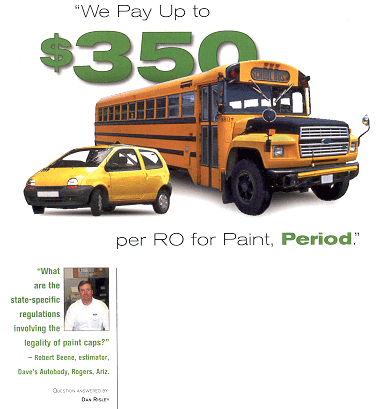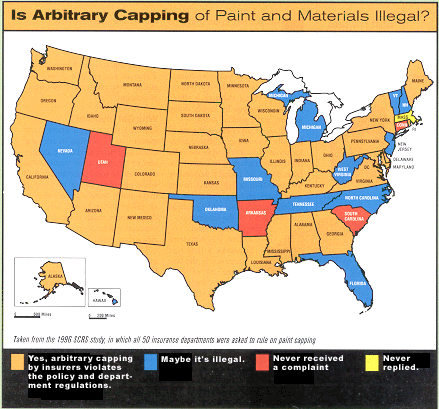
What is paint capping?
Paint capping is a practice instituted by an insurance company that arbitrarily limits the amount of money they reimburse a repair facility for paint and materials on a specific repair order.
To fully understand paint capping, you must first understand how paint and materials are calculated on an estimate. The standard practice in the industry is to multiply the number of refinish hours on an estimate times the shop’s posted hourly rate for paint and materials or the prevailing market rate.
For example, the estimate on Mrs. Jones damaged vehicle was written for 10 hours of refinish time. In Littletown, USA, the market rate for paint and materials is $22. So, if you multiply 10 x $22, you’d have $220 for paint and materials.
Mrs. Jones has XYZ Insurance, and their paint thresholds are $200 for single-stage paint, $250 for two-stage (basecoat/clearcoat) and $300 for three stage. In this example, Mrs. Jones would be under the arbitrary cap of $250 since her vehicle – like most vehicles – is basecoat/clearcoat.
In the event the repair facility had a supplement and added three refinish hours, the estimate would now reflect $286 for paint and materials. Using the initial 10 hours and adding three on the supplement, 13 hours x $22 = $286. Unfortunately, XYZ Insurance is only willing to reimburse the shop up to $250.
Now the repair facility is placed in a precarious situation and has a business decision to make. The repair facility has one of three options and, depending on the situation, one may be more attractive than the other. I’m not too certain that I can make a strong argument for the third option but nonetheless, it’s an option and many of our members have made that decision. They can:
1. Pass the additional cost on to their customer;
2. Contact the insurer, document their costs and seek reimbursement; or
3. Repair the vehicle and absorb the reduction in net profit on that repair.
Although a repair facility may approach each paint-capping situation differently, one thing remains constant: Society of Collision Repair Specialists (SCRS) members and collision repairers all across the country who sought to be reimbursed for paint and materials beyond the threshold have benefited from the report we issued in 1996.
Prior to 1996, the industry faced an improbable task of receiving reimbursement for paint and materials used on a repair when they exceeded the insurance companyÕs arbitrary cap or threshold. Then-SCRS Executive Director John Loftus received countless complaints and requests for assistance. To help, he would often intercede and speak with the insurance company to explain the justified expense. Due to the time involved in resolving these disputes – as well as the increased frequency – Loftus and the SCRS Board of Directors decided to take it to the next level. They were determined to help our membership while educating the industry in the process.
Over the next several months, Loftus wrote letters to department of insurance (DOI) offices in all 50 states. He requested that they respond in writing as to whether or not arbitrary paint capping was illegal in their respective state. SCRS received responses from 49 of them. Thirty-four said it was illegal and 12 said “maybe.” Those that replied “maybe” said it would need to be reviewed on a case-by-case basis. Since the time the study was released, SCRS members have been able to amicably resolve issues with paint caps or thresholds with insurers all across the country. (To view the 1996 SCRS report, click here.)
Unfortunately, the information we’ve gathered is quickly becoming outdated. That being said, we sent out similar letters to the DOIs in the third quarter of 2002. The results we received were very ambiguous because most were reluctant to give a definitive yes or no. I contacted several of the insurance commissioners, and they recommended that I provide another letter with hypothetical scenarios to rule upon. Those letters were mailed in January, and the results will be revealed later this year in an article I write for BSB. To read this letter, see sidebar, “2003 SCRS Paint Capping Study” on pg. 60 of the magazine. If you’re confronted with a paint-capping situation and you seek the difference beyond the arbitrary threshold, what should you do?
Your first step is to contact the adjuster and explain the additional expense. If the adjuster refuses to reimburse you, check to see if you reside in a state where it’s illegal by consulting the 1996 SCRS report or contact your state’s DOI.
Why is paint capping illegal in some states? Insurance is regulated at a state level, not the federal level, so each state has its own laws. What makes paint capping illegal in some states is that consumers who have an actual cash value (ACV) auto policy need to be notified by a declaration of the limit in the original policy if anything is to be arbitrarily limited or capped.
If paint capping is illegal in your state, you obviously have a better chance of getting paid. But even if it’s not illegal, you still want to show the adjuster the 1996 SCRS report (until our new study is completed) and subsequent documentation. Your documentation should include a comprehensive list of the material used serves as an invoice similar to replacing a part on the vehicle.
Documenting your expense isn’t as labor intensive as you may think. There are several tools in the marketplace, some of which have been extremely effective. The following are some of the different methods available:
1. Manually document all materials used and calculate the expense.
2. Utilize an automated system such as the Mitchell Refinishing Materials Guide and Calculator, Com-puterLogic’s new system or a system provided by your paint manufacturer or supplier.
If you’re still unsuccessful in negotiating, contact the adjuster’s supervisor and attempt to resolve the issue with him. Continue this process until you exhaust all options.
Resolving these disagreements entails remaining professional at all times and having supporting documentation. Nobody wins when it becomes argumentative. In most instances, providing the documentation resolves the issue.
Work with the facts and not perception. Guessing you’ve used more material on a job and trying to substantiate it for payment is similar to a customer calling you and requesting an estimate on the number of hours to repair a big dent in his quarter panel. It can’t be done so don’t expect to be successful if you don’t do your homework. Extend the same courtesy to the adjuster as you would your customer, and you may be surprised with the results.
Are you entitled to a markup? Yes. Whether you mark it up – and by how much – is a business decision you need to make. There’s no standard rule, although “fair and reasonable” should factor in to your equation. If you expect to be treated fairly, you need to exhibit the same flexibility when negotiating.
Without a doubt, paint capping continues to be an issue in the industry. Although it’s not as prevalent as it was in 1996, the fact remains that as the faces in the industry change, the education process starts all over again.
It’s up to you to document the facts and to educate those who don’t have the knowledge you possess. Remember, it’s hard to argue facts. But perception is just that: perception.
Writer Dan Risley grew up in the industry, working in his family’s shop as soon as he was old enough to push a broom and pull weeds in the back lot. During his career, he’s also worked for BASF, CCC and Process Claims. He’s currently the executive director of the SCRS.














